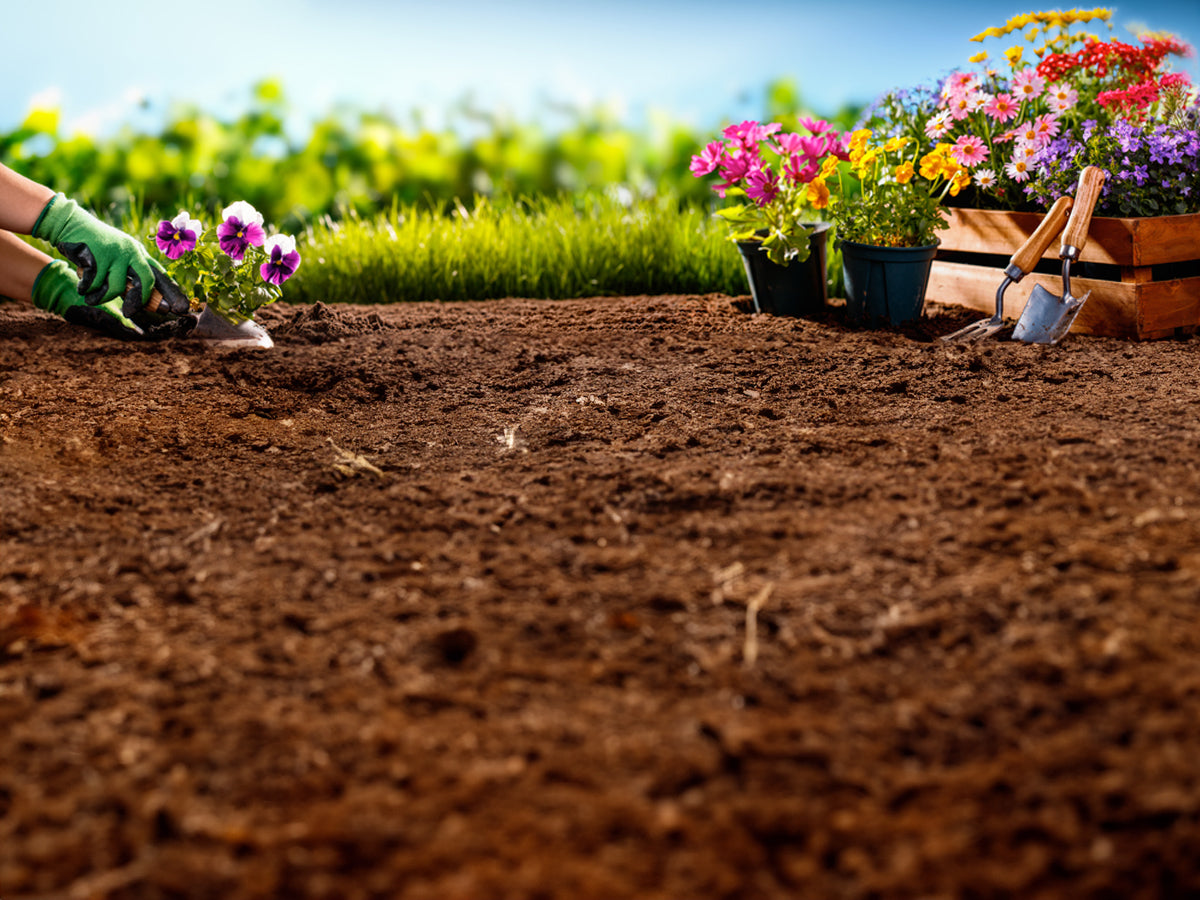How to Grow
How to Create a Sustainable Eco Garden: Check 10 Unique Ideas
“The future is today, not tomorrow.” – Pope John Paul II
There is no better explanation of sustainable development than this quote above. The core idea of sustainability is to change our habits today so that our offspring have a "future" on this planet.
One of the simplest ways to conserve nature is to bring it home, i.e., to create a garden. At this alarming time, it would be best to build a sustainable eco-garden.
Sustainable gardening is not just a list of random gardening practices but a way of life that prioritizes the long-term impact of creating an environmentally conscious space that benefits our planet's future.
Avoiding chemicals, conserving water, or using compost are all parts of eco-gardening which is a commitment to cultivating a space that sustains and nourishes for years to come.
Creating an eco garden can seem daunting, but it can be an enjoyable and rewarding experience with the right knowledge and ideas. We will discuss all these techniques at length here. Take a look at what follows ahead: -
- What is a sustainable eco-garden?
- Reasons why sustainable eco-garden is beneficial
- 10 Unique Ideas to Create a Sustainable Eco-Garden
So, let’s learn the simple eco-gardening techniques that will positively impact the world.
What is a Sustainable Eco-Garden?
A sustainable eco-garden is a garden designed and managed using sustainable practices to reduce waste, conserve water, and minimize harmful chemicals. It promotes biodiversity by providing a source of fresh, organic produce that is free from toxic pesticides and chemicals.
A sustainable eco-garden uses various techniques, such as composting, rainwater harvesting, using organic fertilizers, planting native species, and attracting beneficial insects, to create a healthy ecosystem that supports plant and wildlife growth.
By prioritizing sustainability and reducing its environmental impact, a sustainable eco-garden can provide a model for responsible land use and inspire others to adopt similar practices.
Reasons Why Sustainable Eco-Garden is Beneficial?
Environmental sustainability
Sustainable eco-gardens use organic practices and avoid harmful chemicals and pesticides, promoting biodiversity and supporting a healthy ecosystem.
Reduction of waste
Sustainable eco-gardens reduce waste by composting plant material, using it as fertilizer, and avoiding chemical fertilizers and pesticides.
Healthier produce
By using organic practices, eco-gardens produce healthier, more nutritious food that is free from harmful pesticides and chemicals.
Water conservation
Sustainable eco-gardens conserve water by using drought-tolerant plants, mulching to retain moisture, and using a drip irrigation system that delivers water directly to the roots of the plants.
Cost-effective
Sustainable eco-gardens can save money on gardening supplies by reducing the need for expensive chemical fertilizers and pesticides.
Habitat creation
Sustainable eco-gardens provide a habitat for beneficial insects and other wildlife, which helps to support a healthy ecosystem.
Educational opportunity
Sustainable eco-gardens provide an opportunity to learn about organic gardening practices and environmental sustainability, which can be shared with family and friends.
Reduced harm to wildlife
As chemical fertilizers, pesticides, and other horticultural chemicals are reduced in sustainable eco-gardens, there is less harm to wildlife.
Increase in soil carbon
The conventional methods of agriculture and horticulture have caused a decline in soil carbon due to the removal of organic matter. However, producing compost from food and plant waste and incorporating it into the soil can increase soil carbon. Moreover, this practice promotes the growth of bacteria and fungi, aiding in further carbon sequestration.
Additional practices such as no-dig techniques, green manures, and animal manures can also play a vital role in addressing carbon levels and mitigating the effects of climate change. So, this eco-gardening practice will help us in the long run.
10 Unique Ideas to Create a Sustainable Eco-Garden
May your garden never be devoid of flowers
Effective garden planning involves ensuring that there are blooms throughout the year in a staggered manner. This approach ensures that essential pollinators are continuously attracted to the garden, and that their beneficial effects are sustained across the seasons. One of the best solutions for implementing this idea would be planting perennial flowering plants like hibiscus, marigolds, jasmine, or periwinkle.
For summers, you can plan on growing zinnia, cosmos, gomphrena, etc.; for the rainy season, you may grow plumeria, balsam, or Tecoma/Yellow Elder. And for the winter season, you can grow petunia, aster, dahlia, buttercup, etc.
Grow your favorite vegetables and fruits
Growing fruits, veggies, and herbs is gratifying. Producing some of your own food is a crucial component of sustainable living. Plant intensively and according to the season for a productive, sustainable vegetable plot. Crops like lettuce and greens proliferate in the spring but wither away in the heat of the summer. Hot-weather plants like tomatoes and chilies can be inter-planted in beds. You can re-sow cool weather crops when the fall weather cools off, providing three seasons' worth of food from the same area.
Growing fruits like lemons, strawberries, and cherries and herbs like coriander, dill, thyme, oregano, etc., is easy. Isn't it amazing that you can eat directly from your garden?
Companion planting – a package deal
A practical, sustainable method is utilizing companion planting techniques, such as planting marigolds near tomatoes to repel whiteflies or growing garlic and onions alongside carrots to deter carrot root flies. It is worth researching other flower and crop combinations that can provide similar benefits when grown nearby. By implementing these techniques in your vegetable garden, you can minimize artificial pest control measures and simultaneously enhance the health and yield of your fruit and vegetable crops.
Collect seeds once the blooming season is over
Gather the dried seed heads of annual flowers when the flowering season is over and keep them in a dry location all winter. There is no need to purchase extra seeds since you can plant them in your garden in the spring. You can use marigolds, sunflowers, and morning glory for this.
Choose adaptive or hardy plants
For achieving a sustainable garden, selecting plant varieties that are highly adaptable to different weather conditions and environments is essential. By doing so, these plants will require minimal intervention and maintenance while playing a crucial role in maintaining a healthy ecology within your garden. For example, wood apples, melons, berries, etc., are some of the more resilient types of fruits. Among veggies, eggplant, cucumbers, carrots, peas, tomatoes, beans, etc., is the list you must look out for,
Go for native plants first
If you want to cultivate an eco-friendly garden, it's crucial to understand the appropriate selection of plants. Sustainable plants, also referred to as "natives," are species that are indigenous to your region. These plants necessitate less maintenance, typically need less water, and prosper more effectively than other perennials since they are naturally adapted to your climate, rainfall, and soil type. Moreover, native plant species nourish and shelter the native insect and bird populations.
Mulching
Mulching is an effective method to prevent the growth of unwanted weeds in your garden while also aiding in retaining soil moisture, which is crucial in areas with water restrictions. To achieve this, add a layer of mulch, approximately 2 to 3 inches thick, to your garden beds and around landscape plants. Sustainable mulching options include shredded bark, cocoa bean hulls, pine needles, grass clippings, and coir derived from coconut hulls.
Recycle, reuse, and opt for environment-friendly pots
It is lucid that you cannot discard plastic or environmentally dangerous things in one go. But you can recycle those plastic cans and containers in your garden. You can use one of the milk cans to water your garden. Make drainage holes in another plastic pot to grow a plant. And buy earthen pots from a local shop to promote using environment-friendly things in your garden and support the local business.
Water conservation
When it pours, you must collect! You may use large barrels, large plastic vessels, tubs, etc., to store rainwater. In places where water is limited and scarce, using less water is a crucial component of sustainability. Many lovely drought-tolerant shrubs and perennials are used in xeriscaping, a unique gardening and planting technique that requires less watering.
One of the clever ways to conserve water is to bring home drought-tolerant plants like succulents. Some other ways to save water are:
- Instead of using sprinklers, water only the roots of the plants, avoiding the leaves, and using an eco-friendly watering can.
- Opt for large pots for plants so they won't dry out as quickly.
- Avoid mowing the grass too short in hot weather.
Compost from household waste
Composting is the process of decomposing organic material to create a nutrient-rich soil amendment that can be used in gardening and agriculture. Follow these simple steps to make compost at home:
- Collect organic matter such as fruit and vegetable scraps, eggshells, coffee grounds, tea bags, and garden waste like leaves and grass clippings.
- Choose a composting method that suits your space and needs. Composting can be done in a traditional outdoor bin, a tumbler, or even in a worm bin indoors. Ensure that the compost remains moist. Also, turn it regularly, and keep adequate airflow to encourage the breakdown of the organic matter.
- You will notice that this massive collection of household waste is transformed into nutrient-rich compost that is perfect for improving the health and productivity of your garden.
Remember not to add meat, dairy, and oily foods to your compost, as these materials can attract pests and slow down the decomposition process.
There are so many ways that we all contribute to the growing pollution level worldwide. Creating an eco-friendly garden is an intelligent, generous, and rational approach to contributing to a better tomorrow. Sustainable eco-gardening is a gradual change you can employ in your garden, which would also minimize your carbon footprint. So, read our blog and adopt some of these measures for your garden.
Happy gardening!
FAQs Related to Eco Garden
Why is a sustainable eco garden important?
A sustainable eco-garden is important because it promotes biodiversity, reduces waste, and supports a healthy ecosystem. It also provides a source of fresh, organic produce that is free from harmful pesticides and chemicals.
What sustainable practices can I use in my eco-garden?
Some sustainable practices that you can use in your eco garden are composting, rainwater harvesting, using organic fertilizers, and planting native species that are adapted to the local climate and soil.
How can I reduce waste in my eco garden?
You can reduce waste in your eco garden by composting plant material and using it as fertilizer, using organic pest control methods, and avoiding chemical fertilizers and pesticides.
How can I attract beneficial insects to my eco garden?
You can attract beneficial insects to your eco garden by planting a diverse range of plants that provide nectar and pollen, providing a water source, and avoiding harmful pesticides.



